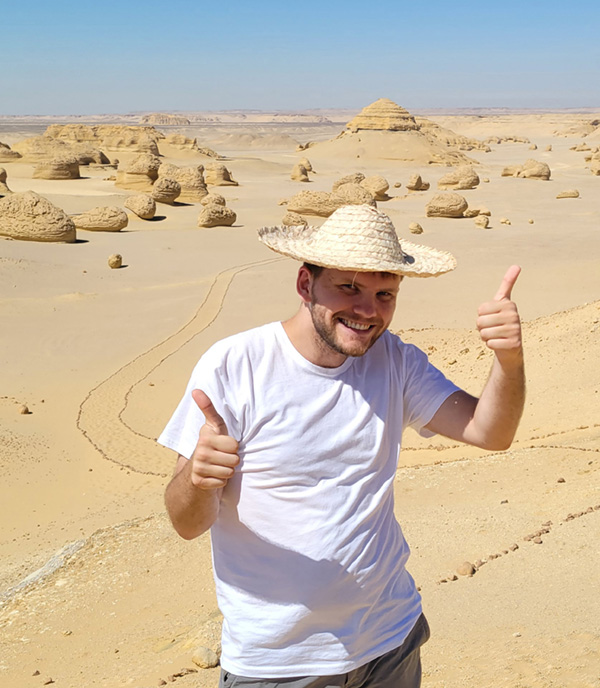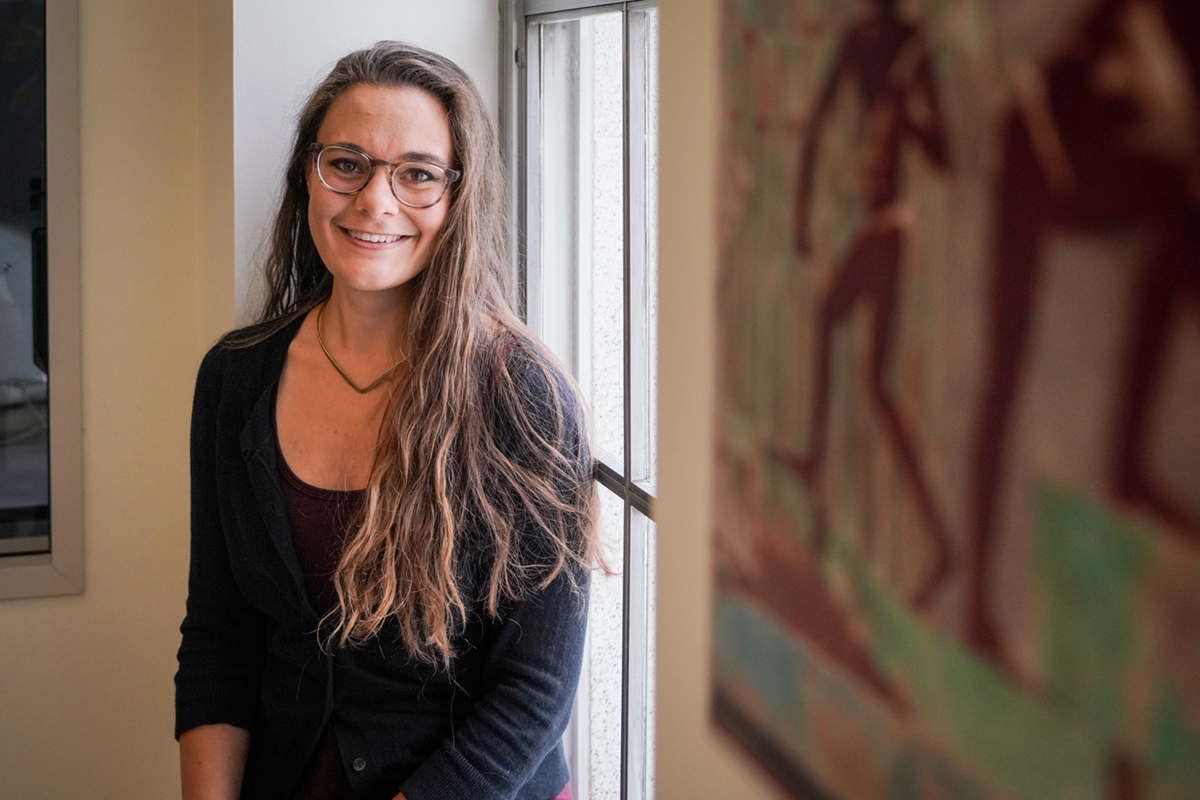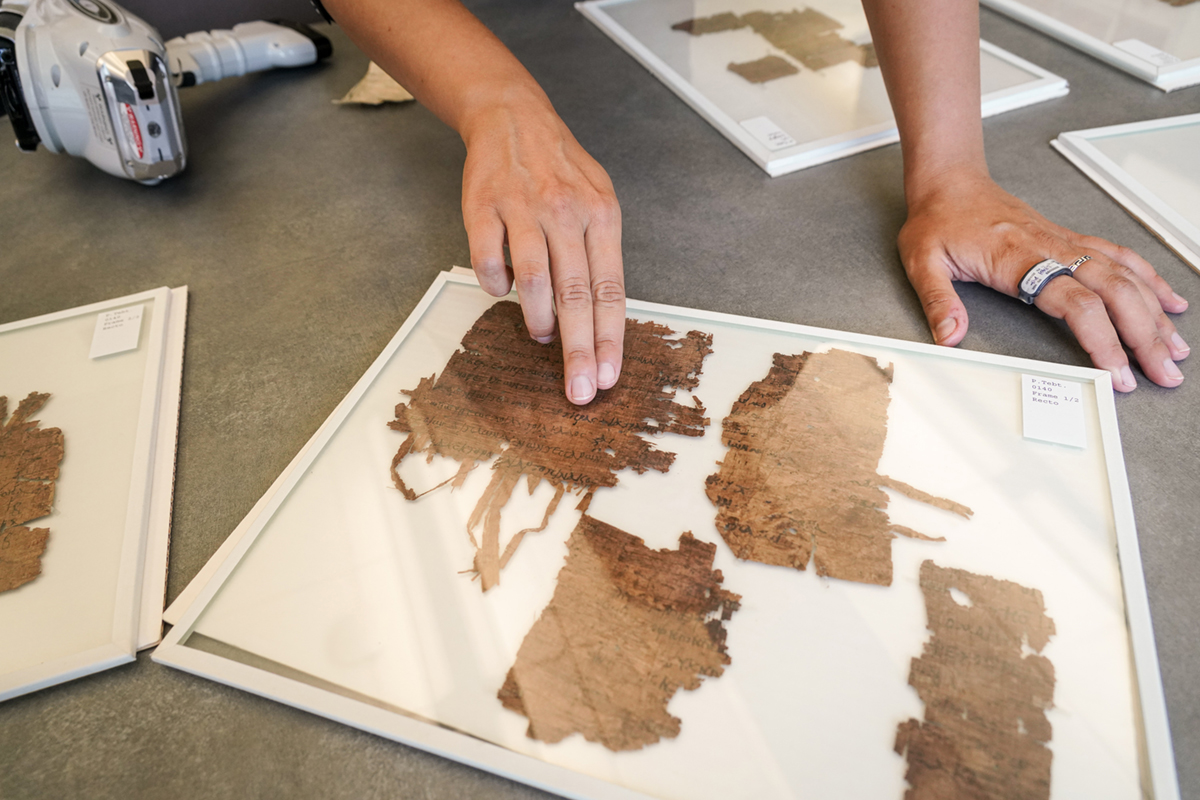Will Sieving didn’t expect to discover something new in the text of a 2,000-year-old fragment of papyrus, especially one that had been pored over by scholars for the better part of a century.
Sieving, then an undergraduate apprentice at UC Berkeley’s Center for the Tebtunis Papyri, simply planned to translate the text and study the associated scholarship. He hoped the research would help him better understand the economics of Ptolemaic Egypt (305 B.C.E.-30 B.C.E.) and inform his senior thesis in the Department of Ancient Greek & Roman Studies.
To Sieving’s surprise — and excitement — he found that his translation diverged from those of all previous scholars. “I see what they were going for,” he says, “but I think (the text) says something else.”
The research offers a fresh solution to a puzzle that has flummoxed papyrology experts for more than 100 years, shining light on the administration of the monetary economy in ancient Egypt — and, as it turns out, altering the course of Sieving’s life.
Reading the signs
Sieving examined the text using high-resolution images from the Egyptian Museum in Cairo, where the artifact is housed. He analyzed each word with painstaking precision, ink stroke by ink stroke. He even studied the markings on the back of the papyrus, where some ink had bled while it was rolled up, allowing him to piece together illegible sections.

The fragment, written in ancient Greek, is a letter from Demetrios, who is thought to be the head of the Alexandrian mint, to the kingdom’s finance minister, Apollonios. Its contents regard the conversion of gold into another currency — and something that seems to be impeding that process. The artifact is well studied because it is seen as a cornerstone in the history of the monetary economy in the Ptolemaic period. In fact, it is the only known source that discusses the regulation of foreign coinage during that time. The papyrus text was first published in 1918.
Sieving’s biggest discovery came in line 16, with one much-debated word. Some scholars have argued that the word is the name of a type of vessel (phialas); others have concluded it was the name of a man (Philaretos). But that man’s name does not appear in other records, leaving the full import of the letter unclear. Sieving’s interpretation, however, suggested a different reading of the name: Philoktas.
Sieving brought the finding to his thesis advisor, Todd Hickey, director of the Center for the Tebtunis Papyri at The Bancroft Library. Hickey recognized the name from inscriptions elsewhere in the ancient Mediterranean; Philoktas appears on Delos as a political and religious delegate from the Alexandrian court. The retranslation, and in particular the connection between Alexandria and Delos, provides a window into the little-known inner workings of the Ptolemaic government and its interactions with communities outside of Egypt.
Hickey, who has led the center since 2011, hopes Sieving will publish the research soon.
“We’re looking at these papyri as sort of building blocks for historical narrative, and this one, … maybe the central one for this particular historical question, was a bit shaky, or at least open to multiple interpretations,” Hickey says. “I think Will’s handling of this document has put that key building block on a firmer foundation. It’s wonderful to see.”
Student contributions to scholarship
The discovery is not the first by an undergraduate during Hickey’s two decades at the center, but it is probably the most impressive, he says.
The achievement also speaks to the importance of including undergraduates in papyrology research, an opportunity that is rare at other universities, and one that Hickey has championed during his stewardship of the center. For 20 years, students from Cal’s Undergraduate Research Apprentice Program, including Sieving, have gotten hands-on experience with these precious artifacts.
And there’s plenty more work to be done. The center holds the largest collection of papyri in the Americas, with more than 25,000 fragments. Only a small portion of those have been studied. Hickey says that providing access to as many fragments as possible — and thus facilitating the advancement of the field’s body of knowledge — is the center’s primary purpose.
Sieving, who graduated in December 2022, made the most of his three semesters at the center. His research experience helped him land a prestigious Pearson Fellowship from the Society for Classical Studies. He is currently pursuing a Master of Studies in Greek and Roman History at the University of Oxford, in England.
“None of this would have been possible without the resources that the (center) and Bancroft provide,” he says. “Being surrounded by people who know so much — it’s an unparalleled experience.”

Leah Packard-Grams, a doctoral candidate in the Graduate Group in Ancient History and Mediterranean Archaeology, is also taking advantage of her time at the center.
Packard-Grams made a recent discovery while studying a scribe’s archive, containing lists, contracts, and personal accounts from circa 70s B.C.E.-60s B.C.E., from the center’s collection. The man’s handwriting indicates his use of a kalamos (reed pen), rather than the traditional rush, to write in Demotic, an ancient Egyptian script. Yet the scribe worked decades before the kalamos was regularly employed to write that language.
Packard-Grams wondered if the innovative scribe also used an “atypical” ink. To find out, she performed a chemical analysis, using X-ray fluorescence spectrometry to determine the ink’s ingredients. (The scan was done in collaboration with UC Berkeley’s Archaeological Research Facility.) Similar analyses of papyri from this period have revealed the addition of copper sulfate and other metallic elements to the traditional Egyptian ink recipe of gum arabic, soot, and water.
“It turns out that he adopted the pen but chose to retain the traditional ink,” Packard-Grams says. “He didn’t feel this fancy copper recipe was needed, evidently. Or maybe he didn’t have access to it. Maybe it was more expensive. There are a lot of theories about why heavy metals were added to inks of this period. And there’s a lot of debate.”
Making a mark
Packard-Grams says the study shows how long-standing Egyptian ink recipes survived amid later innovations, and how there is not necessarily a correlation between writing instruments and ink recipes. She won first prize for a poster detailing her research at the annual meeting of Egyptologists in the U.S. last year.
Packard-Grams is fascinated by the materiality of papyri because it presents a direct connection to the past. “Papyri are not just text-bearing or illustrative artifacts; they’re three-dimensional objects,” she says. “(This project) is a really concrete way for me to communicate to people that papyri are indexes of a past human body, of a past human person, who had to pick up the pen, dip the pen into the ink he chose, … and take the time to write out his thoughts.

“For me to sit here and look at this papyrus is to connect with a specific scribe in a specific moment in time. It’s a connection through history. It’s like time travel. And it’s really magical.”
For Hickey, the director of the center, Packard-Grams’ findings show that there is always more to learn. The research is another example of how students are contributing to the understanding of the ancient world — and often illuminating unique perspectives.
He says that while many historical texts are written by or about those in the ruling class, papyri offer insights into the lives of a much broader swath of people.
“(We are) surfacing the voices of people that we don’t know anything about otherwise,” Hickey says. “It’s this access to parts of antiquity that are either silenced by or silent in elite discourse but that are revealed in the papyri, that makes them, I think, really attractive. These are documents that they (non-elites) either wrote, or were written about them, or they appear as subjects in them.
“This material is precious because without it, our knowledge of antiquity and, in particular, of marginalized groups in antiquity is much diminished.”